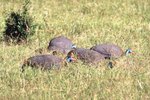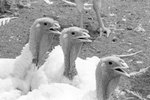About 50 percent of hatched chickens are pullets; the other half are cockerels. If you hatch your own chickens, or if you buy straight-run chicks, you're likely to have some cockerels in with the pullets. The easiest way to determine their sexes is to see if they either crow or lay an egg. If the bird crows, it's obviously a cockerel. If it lays an egg, it's a pullet. But you may want to determine the sex of your chicks before either occurrence.
Body and Legs
Cockerels have bigger bodies and thicker legs than pullets. When comparing chicks of the same age, the cockerels' legs will appear much larger, even when their bodies don't seem to be different in size.
Combs and Wattles
The cockerels' combs are usually more developed and larger than pullets' combs at least among birds of the same age. Cockerels' combs turn red sooner than pullets', and their wattles are larger and redder. Pullets' combs may flop over; cockerels' combs will stand upright.
Feathering
Cockerels have pointed feathers on their necks, known as hackle feathers. Pullets have rounded feathers on their necks. Cockerels also have pointed feathers on their backs known as saddle feathers. Cockerels also have curved tail feathers known as sickle feathers. Pullets have straight feathers on their tails; all feathers on pullets have rounded ends.
Plumage Coloration
Cockerels will start developing more brightly colored feathers than pullets. They will also have more iridescence and color variety to their feathers than the pullets.
References
- Raising Chickens for Dummies; Kimberly Willis and Rob Ludlow, pp 223-227
- My Pet Chicken; At What Age Does a Rooster Begin Crowing?
- SageHenFarmLodi.com; Sexing Chicks After a Few Weeks
- University of Florida Extension, Institute of Food and Agricultural Sciences; Sex Reversal and Chickens
- University of Florida Extension, Institute of Food and Agricultural Sciences; Sex Reversal and Chickens





